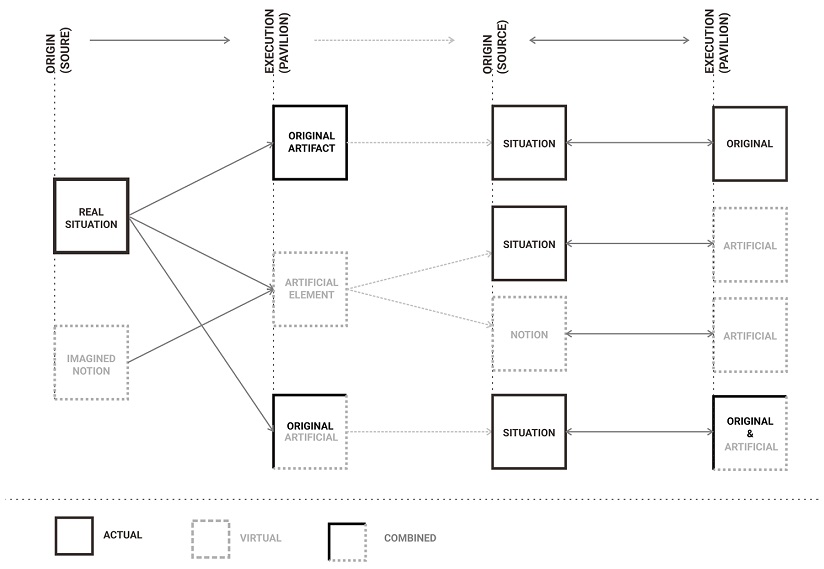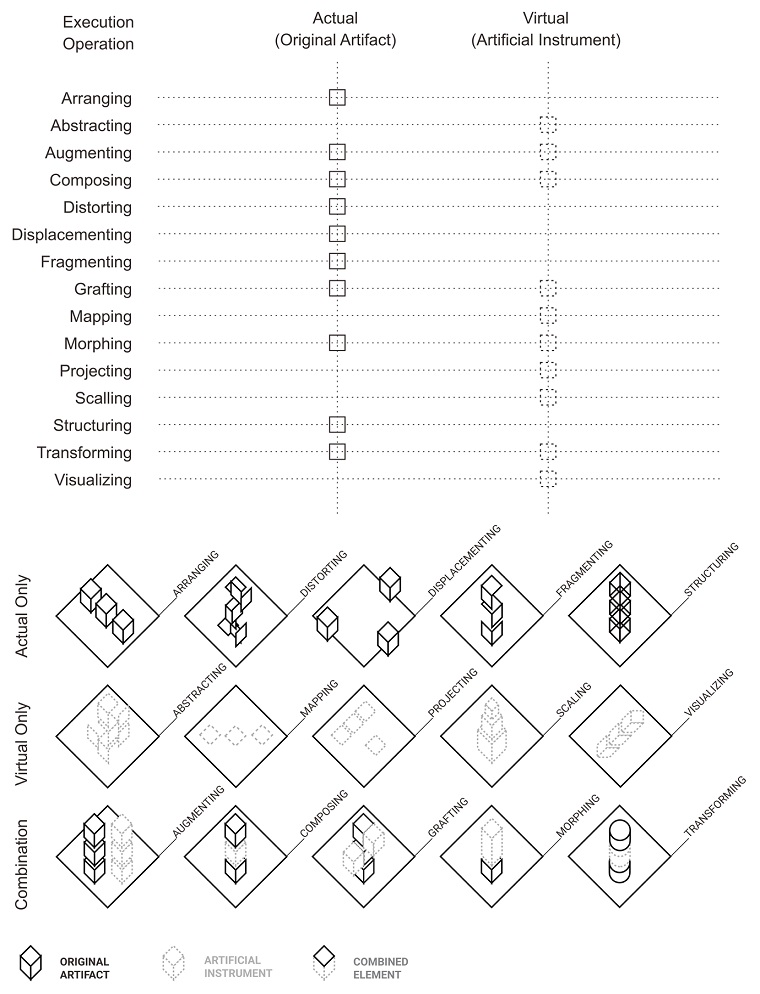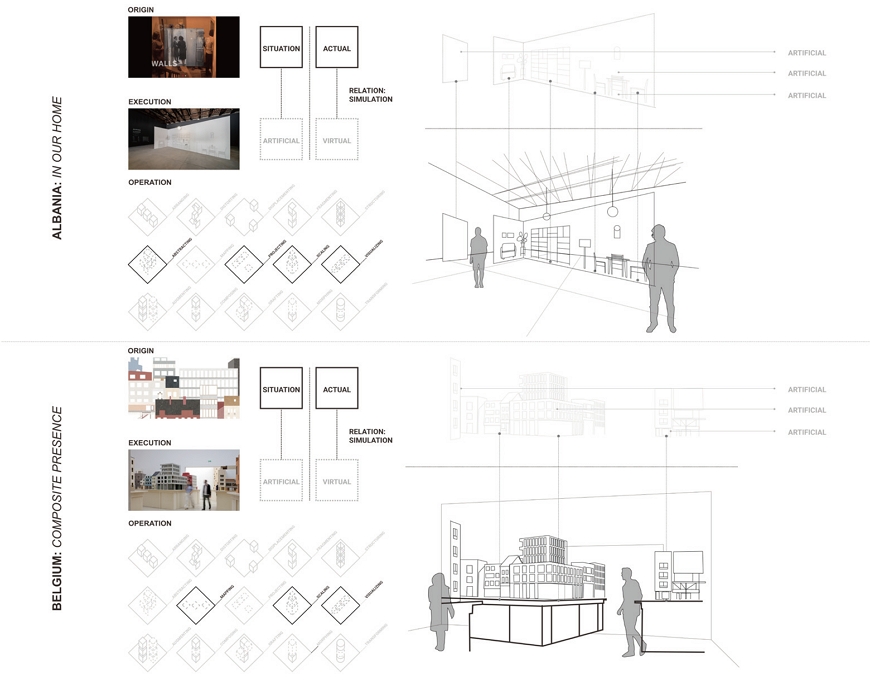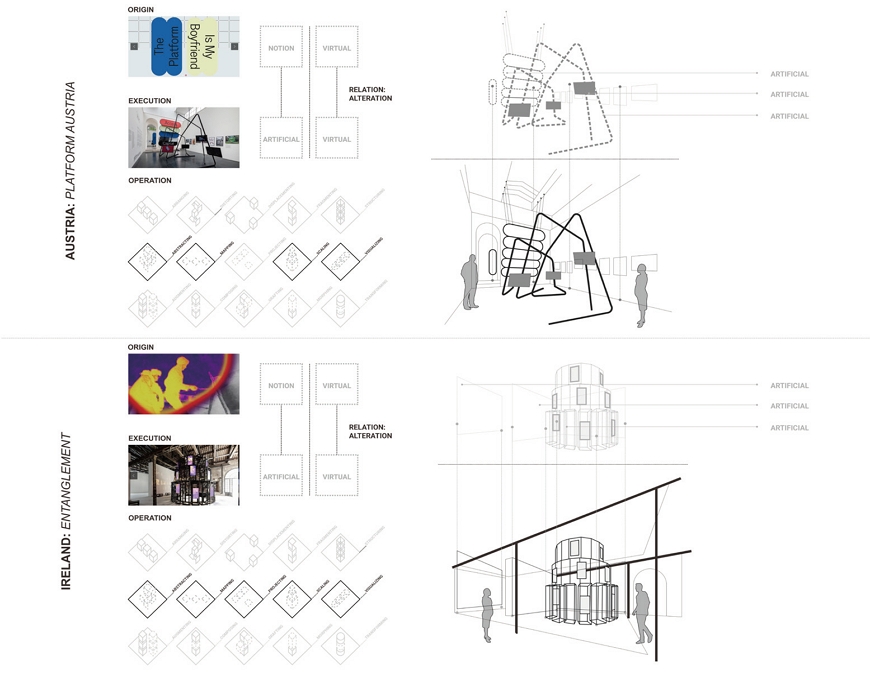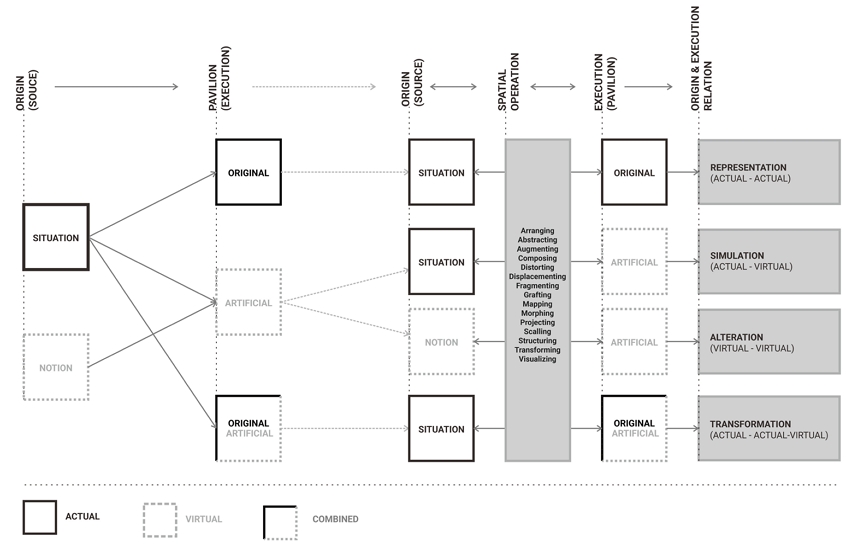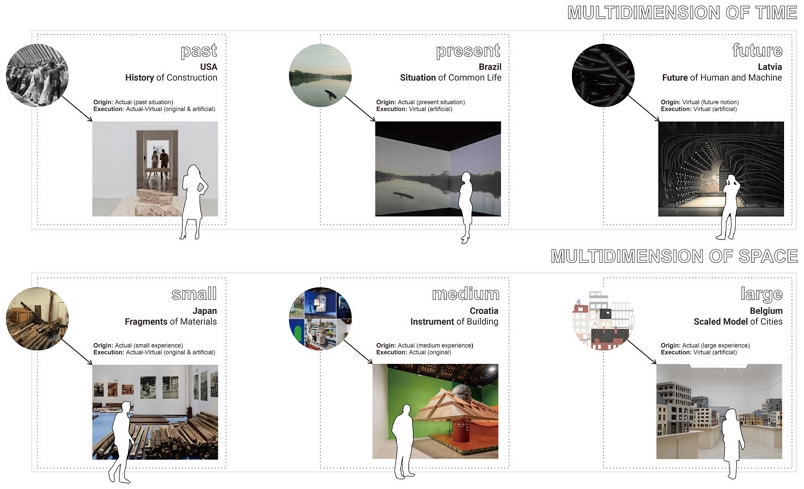
Mapping The Actual-Virtual in Architecture Exhibition
Abstract
Background This study aims to identify, map, and reflect on actual-virtual relations in architectural design practices. Virtuality is more than just a discourse of technology. Virtuality is an attempt to realize unlimited possibilities. This study uses the context of the Venice Architecture Biennale (2021) exhibition with the theme 'How Will We Live Together?' to illustrate various possibilities of space construction through the actual-virtual framework.
Methods The identification of actual-virtual is performed by qualitatively decomposing the case studies of 60 pavilions. The analysis is carried out by drawing and retracing the data for each pavilion to discover various actual-virtual instruments, operations, and relations in the exhibition. Reflection on the actual-virtual concept that traverses multiple dimensions of space and time, becomes the basis for seeing actual-virtual as a potential.
Results This study reveals various types of actual-virtual operations and relations in the context of architectural exhibitions. The connection between origin and execution in exhibitions parallels the actual-virtual relational framework. Disassembling the case study also demonstrates the actual-virtual possibility as a design instrument that connects multidimensional space and time.
Conclusions This study offers to deliver another perspective on actual-virtual relations in architecture. This study expands the actual-virtual abstract and conceptual discourse into more practical and operative perspectives. The findings demonstrate the possibility of broadening design knowledge based on an actual-virtual relational framework in an architectural context.
Keywords:
Actual-Virtual, Relations, Spatial Operations, Exhibition, Multidimensions1. Introduction
1. 1. Actual-Virtual as Relational Entities
‘The relationship between the virtual and the actual is one of surprise, for the virtual promises something different to the actual that it produces, and always contains in it the potential for something other than the actual’ (Grosz, 2001, p. 11).
This study adopts a conceptual idea from Elizabeth Grosz (2001), who states that the actual and the virtual are interrelated and have the potential to present something more than the actual itself. The idea of actual-virtual has been widely discussed as an abstract thought. However, the practical design perspective discussion is still lacking compared to the technological perspective. Virtuality is not limited to digital design approaches but also the actual processes that materialize the virtual (Jecu, 2015; Kalaga, 2003). Identifying the interrelated instruments in the spatial context can reflect the actual-virtual relational concept.
Actual-virtual presents a relational idea of multiplicities. There is no pure actual object, and a relative virtual image always comes with it (Deleuze & Parnet, 2007; Grosz, 2001). Discussing multiplicity in architecture means opening up the possibility of alterations in meaning, experience, and practice (Paramita, 2022). Actual-virtual in this study is proposed and identified as a relational idea that is more than just an abstract thought but as the potential to be reflected in the development of the spatial design practice.
1. 2. Actual-Virtual Relation on Exhibition Spatial Practice
Architectural exhibitions are contextual media of spatial practice to discover the actual-virtual. Architecture exhibitions curate and reflect on ideas, possibilities, and thinking across disciplines, which open the boundaries of architecture beyond buildings (Bondesan, 2022; Brown & Szacka, 2019; Szacka, 2016). The exhibition's design and spatial response to various issues present a new reality, a parallel virtual model related to the future (Lee, 2015; Nash et al., 2021). The concept of parallel space relates two things in the context of the exhibition: the idea as the origin of the exhibition and the spatial translation as the execution of how the idea is implemented and constructed in the exhibition design.
Reading the relational origin and execution in the exhibition can reflect the actual-virtual relation. Virtual is not a separate reality but a new perspective on actual conditions (Jecu, 2015). Fantasy and creativity are not limited to conditions and situations but also imagination, representation, and virtuality (Papasarantou, 2020). Based on those arguments, we can say origin can be divided into two characters. Origin or ideas originating from a real situation are called the actual. On the other side, imaginative notions or conceptual ideas, which have yet to materialize, are called the virtual.
Meanwhile, execution relates to the realization of ideas. In the context of exhibitions, actual means original artifacts, while virtual means representation of something outside of it or something artificial (Gay, 2001; Levy et al., 2010). Virtuality is always around us, accessible through spatial and material portals, mediated by memory and imagination (Kalaga, 2003). Based on those arguments, the execution can be divided into two characters. Execution that uses the original artifact can be called the actual. In contrast, execution assisted by artificial recreations in various forms and scales can be called the virtual. The scope of origin and execution and their position in the actual-virtual relational diagram is illustrated in Figure 1.
Spatial operation in an exhibition is translated into a representation of something that is time and space limited. Architectural exhibitions perform beyond the objects and physical presence. Actual-virtual presents a discussion of spatial design that is related to representation and substitution (Virilio & Ruby, 1998; Virilio & Wilson, 1994). It represents various contexts within limitations through representational techniques of an indirect dimensional and immersive model (Atmodiwirjo & Yatmo, 2020; Brown & Szacka, 2019; Francis, 2015; Zizek, 1996).
Multiple strategies and operations related to actual-virtual in the exhibition have the potential to open up various design approaches. The Venice Architecture Biennale (VAB) can become a contextual case study, especially the exhibition of national pavilions from various countries. VAB can reflect current global conditions, demonstrating the exchange of technological and material knowledge, as well as multi-context and locality interactions that blend boundaries (Martini, 2010). The conceptual architecture presented at the exhibition demonstrates various forms of creativity through the collection, representation, and organization of various things to understand this world (Betsky, 2005; Cull, 2015; Dudley, 2019). VAB 2021 comes with the theme of how living space in the future is conceptualized (Sarkis, 2019). With the global pandemic conditions bringing humans closer to virtual concepts (Sarkis et al., 2021), this exhibition becomes a suitable case study to reveal new perspectives from actual-virtual relations in spatial practice.
1. 3. Actual-Virtual of Multidimensional Space
Reading actual-virtual as a spatial relation and operation allows modification and alteration of multidimensional aspects. Virtuality can modify the understanding of time and space (Clear, 2011; Crang, 2001). Multiverse is a concept in which different spaces, locations, and times can have the same conditions and design solutions (Deutsch, 2005; Flachbart & Weibel, 2005; Jordan, 2009). Architectural exhibitions operate like parallel portal worlds, connecting actual conditions in virtual models in the exhibition space. The virtual perspective posits the past, present, and future simultaneously, where there is no clear concept of time, running parallel and coexisting (Hernan & Ramirez-Figueroa, 2021; Kalaga, 2003). Multidimensional ideas can enrich the experience of space into wider virtuality.
Actual-virtual is not only able to extend multi-dimensional time but also the scale of space. An exhibition is a mixed reality that blends scale and detail and duplicates actual space in experiential virtual entities and models (Caldas & Keshavarzi, 2019; Downey, 2014; Graham et al., 2019; Till, 2006). The dynamics of scale and time, and the multi-dimensional aspect that it can represent, is the potential contained in understanding the actual-virtual in exhibition practice. This study identifies and maps the actual-virtual relation in exhibition practice to expand the spatial design approach.
2. Method
This study is conducted through a qualitative approach using case studies of dissasembling of the national pavilion at VAB 2021, dismantled to find actual-virtual instruments, including operations, relationships, and dynamics within them. The data is collected from the official VAB website in the form of photos, videos, and narrations from the curators of each pavilion. The analysis uses the redrawing and tracing method of 60 pavilions from national participants. Drawing can be an investigation and analysis tool (Carpo & Lemerle, 2013; Cook, 2013), and tracing is a method for understanding what is hidden in it. Visual image-based research methods refer to the activity of copying operations (interrogation and composition), collaboration (dialogue), image attention (understanding phenomena), and orthographic projection (materiality and form) (Lucas, 2016). ‘The virtual is a projected form of the present, relocating it to the future, and to alterity’ (Lucas, 2019, p. 171). This study aims to identify and map the actual-virtual aspect of the relations, operations, and spatial dynamics that occur in it. These results reflect a new perspective on actual-virtual expansion in developing architectural design approaches. Figure 2 demonstrates the flow of analysis in this study.
3. Result
3. 1. The Operation: Re-creation of actual-virtual spatiality
Operations in this study include the design and spatial strategy carried out by each pavilion to translate ideas from origin to execution on the exhibition venue. Based on the actual-virtual conditions of the origin from 60 national pavilions, it can be identified that execution operations are using original artifacts, artificial instruments, and a combination of both.
The first category, using only original (actual) artifacts, is performed by compiling, distorting, changing the layout, breaking up fragments, and structuring. The second category, using artificial (virtual) instruments, is performed by re-creating through abstracting, mapping, projecting into a medium, scalable modeling, and visualizing through various media, photos, audio, and video. The last category combines original artifacts and artificial instruments (actual & virtual), carried out using augmentation techniques, composing, grafting, and transforming forms. Each operation is illustrated as shown in figure 3.
3. 2. The Relation: Reconciliation of actual-virtual connection
This study generally examines the possible relationships in exhibitions by identifying the connections between origin and execution. According to the exploration, the relationship between the two can be reflected in the actual-virtual character. The origin or source of design can be classified into two categories: real situation or (actual) origin and imaginative (virtual) origin. Execution or implementation in the pavilion is also classified into two categories, namely execution using original (actual) artifacts and artificial (virtual) instruments as a translation of the initial idea. Figure 4 demonstrates the relationship between origin and execution from an actual-virtual perspective from the 60 pavilions of VAB 2021.
According to the mapping in Figure 4, four possible relationships are formed between origin and execution in their respective actual-virtual viewpoints. The origin-execution relation above includes the actual-actual (representation), actual-virtual (simulation), virtual-virtual (alteration), and actual-actual & virtual (transformation) categories.
The first relationship between origin-execution in VAB 2021 is the representation (actual-actual). Representation means objects that are not entirely, only partially (Arya, 2019; Whyte, 2007), and are projections of the most significant fragments (Beckmann, 1998; Grosz, 2001). Representational relations are well illustrated through the Croatia and Japan pavilion. The Croatia pavilion brings togetherness through building fragments of the original building from the country to the exhibition venue in Venice. The Japan pavilion did performs quite similarly, bringing the trajectories of construction elements, primarily the wooden sub structures, from the country. This partial fragment representation demonstrates the actual-actual relation in the context of origin and execution of the exhibition, as illustrated in Figure 5.
The relationship between origin-execution in the second VAB 2021 is a simulation (actual-virtual). Simulation has an understanding that is not limited to imitation, but there are modifications in reality (Jecu, 2010). The simulation also means dematerialization, not merely re-transcription, a copy of reality with an emphasis on certain conditions, which enriches a piece of information (Grosz, 2001; Whyte, 2007). Simulation is part of shaping the experience, as well as enriching representation (Eloy, 2022; Miltiadis, 2020). These arguments reinforce that simulation means that it is not only a reflection of the actual condition but also modifications and additions of information, which focuses on dematerialization. It is also understandable that there are attempts to make interpretations completely artificial (virtual) without any original objects (actual). Simulation relations are well illustrated through the Albanian and Belgian pavilions. The Albanian pavilion presents the idea of communal space in the domestic space through the dematerialization of various domestic instruments. They used this spatial concept to highlight the shared space in their domestic housing. Like Albania, which does not present actual objects, The Belgium pavilion tries to answer the theme by presenting togetherness through reduced-scale city figures or urban fabrics. There are no actual or original objects in the two pavilions; both focus on artificial (virtual) objects so that they can present the conditioning of large objects in a limited exhibition space. This simulation of information and conditions demonstrates actual-virtual relations in the context of origin and execution of the exhibition, as illustrated in Figure 6.
The third relationship between origin-execution in VAB 2021 is an alteration (virtual-virtual). Alteration can be interpreted as a change from the original reference condition or object, which leads to a change in a particular variation (Jecu, 2010; Massumi, 1998). The alteration also means a conceptual rearrangement of the schema, free from the attachment of certain constraints (Grosz, 2001; Miltiadis, 2020). The relation of alteration is well illustrated through the Austrian and Irish pavilions. These two countries base their pavilion inspiration on something other than actual conditions that already exist and occur but rather lead to the imagination of a particular idea. The Austria pavilion is trying to rethink the concept of a digital platform as an interaction space. The interpretation translation of this idea is to bring the elements of the digital platform into the physical space. The alteration that occurs is a change in the digital platform from the virtual world to the physical world. Meanwhile, The Ireland pavilion has a similar approach. The Ireland pavilion tries to re-understand the space that is constructed from the idea of digital devices. In contrast to platform-focused Austria, Ireland is trying to alter technology hardware into shared living space construction. There is no actual interpretation, and inspiration also comes from ideas that have not been realized before, namely altering digital space and technological, mechanical devices as physical space. This alteration of digital hardware and software demonstrates virtual-virtual relationships in the context of origin and execution of the exhibition, as illustrated in Figure 7.
The relationship between origin-execution in the last VAB 2021 is the transformation (actual-actual&virtual). Transformation is a change process through negotiation between the actual and the virtual, both in the form of augmentation and supplementation (Grosz, 2001). We can achieve transformation through connection and dialogue between actual-virtual in the reconstruction of the potential of an object (Ruberto, 2021). Transformation and alteration have a close understanding, namely the emergence of new configurations. Still, the difference is that alteration describes the variation of conditions, while transformation is the process (Massumi, 1998). We can understand the transformation of an object through connection-based explanation and dialogue with its environment (Iser et al., 1998). Transformational relations are well illustrated through the UAE and Singapore pavilions. The UAE pavilion demonstrates inspiration in the form of actual objects, namely natural objects, combined with actual-virtual combination interpretations with videos and illustrations of future living spaces of these natural objects. There is a change or transformation of natural objects into instruments of space construction. The Singapore pavilion does not construct a new space but interprets social space differently from the actual-virtual combination of object interpretation. Table and chair objects are combined with virtual instruments through illustrations, scale models, and videos of shared space ideas. The two pavilions carefully look at the opportunity for the combination of interpretations of their original (actual) artifact to be constructed differently through their combination with artificial (actual-virtual) instruments. The transformation of the original (actual) artifact occurs through new combinations with artificial (actual-virtual) elements, as illustrated in Figure 8.
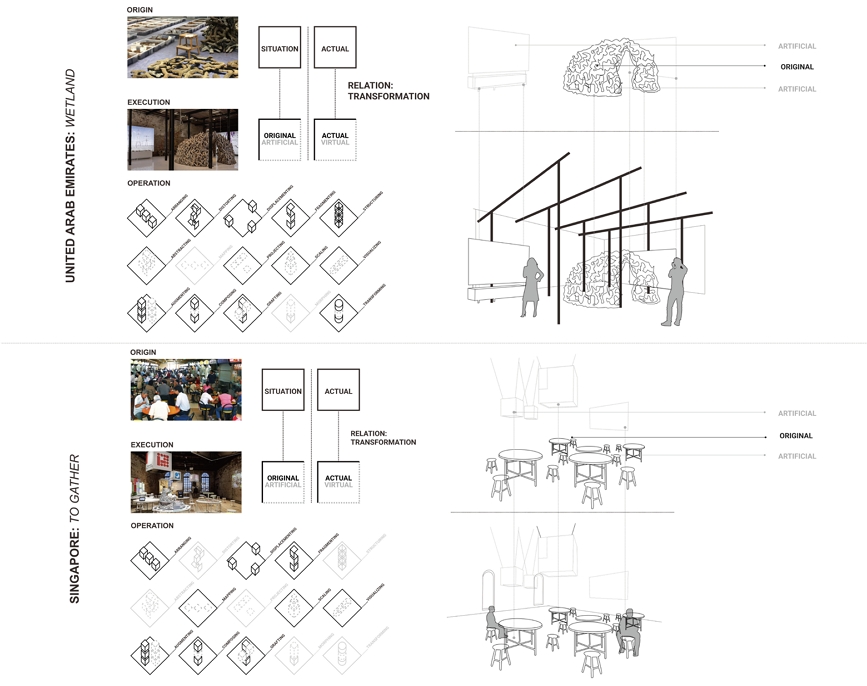
The transformation relation, connecting the actual origin and execution of the actual virtual combinations
If reflected in the study framework at the beginning of the article, the operations and relations in the VAB 2021 exhibition have the appropriate position, as demonstrated in figure 9. Actual-virtual spatial operations allow translation from origin to design execution in the pavilion. The possibility of actual, virtual, or a combination of both operations makes designer creativity more open. The actual-virtual relation is the connection between origin and execution, where there are four types of possible connection/relation.
3. 3. The Dynamics: Multi dimensionality of actual-virtual time and space
Through the exploration above, actual-virtual operation and relation have the potential to connect multi-dimensions, both in space and time. Virtuality can modify the present conception of the time and space dimension (Clear, 2011; Crang, 2001). The multiverse concept, where different spaces, locations, and times have similar conditions (Flachbart & Weibel, 2005; Jordan, 2009) also demonstrated through various pavilions. The connection of multiple dimension of time and space, also related to particular spatial operation.
Based on the time dimension, actual-virtual can be a potential instrument to create past-present-future interactions. Time in the exhibition concept becomes a narrative instrument that is different from real-time (Nathania & Wahid, 2022). The time portal opens through exhibit objects with virtual entities traversing the periods. Speculation of future space can be constructed by re-reading the past and the present from the perspective of an evolutive context (Spiller, 2020). Based on the idea of past time, the USA pavilion uses architectural instruments from the past to be reinterpreted in constructing shared spaces in the future. In the concept of the present time, the Brazil pavilion demonstrates the redefinition of urban areas for possible future spaces. Meanwhile, from a future perspective, the Latvian pavilion shows the possibility of machine integration in human living space. These three illustrations support the argument that in spatial construction, opportunities are expanded through objects with virtual entities that are wider than themselves. Actual and combined actual-virtual operations can strengthen space design's concept of past and present times. In contrast, the idea of future time can only be supported with the intensive use of virtual operation.
Based on the dimensions of space, actual-virtual can be a potential instrument for presenting a more dynamic spatial experience. Exhibition space can be positioned as a virtual model duplicating the actual space configuration in freedom of scale (Till, 2006). The exhibition object is a portal that can open the same virtual entity, more minor or even more significant than the actual spatial dimension (Kalaga, 2003). The Japanese pavilion demonstrated the smallest building instrument, which uses building demolition material to create an exhibition space. The Croatia pavilion tried to use building instruments like roofs and walls to reconstruct a new exhibition space on an accurate scale. The Belgium pavilion became an enormous scale demonstration by presenting a scale model of their urban fabric to interpret shared space from a macro scale. The three pavilions show the possibility of experiencing space with virtual entities, which can be smaller or much larger than the actual objects in the exhibition. Figure 10 presents the dynamic multidimensional possibilities in the exhibition's concept of space and time.
4. Reflection
Several things related to design and research practice can be reflected based on the studies of the exhibition actual-virtual framework. From practical design perspective, the actual-virtual relation can be used as a reference for the representation mechanism of design instruments, where virtuality opens opportunities for alternative creative representation. Various artificial instruments can expand the limited presence of physical or original instruments in the design. They can also be a collaboration of digital/technological virtual entities in forming an experience based on the similarity of the instruments attributes. In a broader scope, this mechanism is not limited to exhibition practices and can be expanded to other spatial-based design practices.
From the design research perspective, actual-virtual relations can be a paradigm in reading the spatial operations of particular space. The spatiality is not only found at the exhibition but also in various other spatial practice and phenomena. Mapping the actual-virtual relation framework (framework level) can disassemble other relational representations in design cases. By considering the actual-virtual relations, we can position design knowledge as an extension of seeing spatial medium as more than a single entity. The virtuality paradigm as an ideal image, opens opportunities to study spatial designs from various dimensions (spatial imagination, technology representation, augmented visualization, etc.).
5. Conclusion
The results of the identification and actual-virtual relational mapping regarding the VAB 2021 national pavilion demonstrate that actual-virtual discourse is not limited to conceptual, thinking, and technological. The new perspective regarding actual-virtual as a relation and operation shows the possibility of expanding spatial design into more varied dynamics.
In the discussion of actual-virtual space dynamics, space is capable of presenting experiences in accordance with what is seen directly, and architectural instruments work like a portal. Existing portals can connect various virtual entities that the designer can creatively define. Virtuality is not a separate reality but a new perspective on actual conditions. Virtuality can be read as an opportunity and possibility to bring vision and imagination closer together in a more operative and practical way.
This study may only be a small part of actual-virtual exploration in architecture. Case studies limited to the VAB 2021 national pavilions are also an opportunity for further, broader, in-depth future studies. Nevertheless, this study offers a new perspective on actual-virtual relations in architecture that opens up different opportunities to develop spatial design practices that respond to multiple and various issues.
Acknowledgments
This work was funded by Seed Funding Profesor Fakultas Teknik Universitas Indonesia 2022/2023 under contract no: NKB-1968/UN2.F4.D/PPM.00.00/2022
Notes
Copyright : This is an Open Access article distributed under the terms of the Creative Commons Attribution Non-Commercial License (http://creativecommons.org/licenses/by-nc/3.0/), which permits unrestricted educational and non-commercial use, provided the original work is properly cited.
References
-
Arya, R. (2019). Virtual Space. A Companion to Contemporary Design since 1945, 137-156.
[https://doi.org/10.1002/9781119112297.ch7]

-
Atmodiwirjo, P., & Yatmo, Y. A. (2020). "Tanahku Indonesia": On Materialscape as the Materiality of a Nation. Architecture and Culture, 8(2), 328-349.
[https://doi.org/10.1080/20507828.2020.1774850]

- Beckmann, J. (1998). The Virtual Dimension: Architecture, Representation, and Crash Culture. Princeton Architectural Press.
-
Betsky, A. (2005). From Box to Intersection. In Disappearing Architecture (pp. 250-257). Springer.
[https://doi.org/10.1007/3-7643-7674-0_21]

- Bondesan, C. (2022). "How Will We Live Together?": The Japanese Answer to the 2021 Venice Architecture Biennale.
-
Brown, A., & Szacka, L. C. (2019). The Architecture Exhibition as Environment. Architectural Theory Review, 23(1), 1-4.
[https://doi.org/10.1080/13264826.2019.1616369]

-
Caldas, L., & Keshavarzi, M. (2019). Design Immersion and Virtual Presence. Technology Architecture and Design, 3(2), 249-251.
[https://doi.org/10.1080/24751448.2019.1640544]

-
Carpo, M., & Lemerle, F. (2013). Perspective, projections and design: technologies of architectural representation. Routledge.
[https://doi.org/10.4324/9780203715574]

-
Clear, N. (2011). AVATAR and the politics of Protocell Architecture. Architectural Design, 81(2), 122-127.
[https://doi.org/10.1002/ad.1220]

-
Cook, P. (2013). Looking and drawing. Architectural Design, 83(5), 80-87.
[https://doi.org/10.1002/ad.1638]

-
Crang, M. (2001). Public space, urban space and electronic space. Virtual Globalization : Virtual Spaces/Tourist Spaces / David Holmes, 37(2), 301-317.
[https://doi.org/10.1080/0042098002203]

-
Cull, N. J. (2015). Editorial: Building a reputation; Sharing an environment: Architecture and public diplomacy at the Venice Biennale of architecture, 2014. Place Branding and Public Diplomacy, 11(1), 1-4.
[https://doi.org/10.1057/pb.2015.1]

- Deleuze, G., & Parnet, C. (2007). dialogues II. Columbia University Press.
-
Deutsch, D. (2005). The Architecture of the Multiverse. In Disappearing Architecture (pp. 24-29). Springer.
[https://doi.org/10.1007/3-7643-7674-0_3]

-
Downey, S. (2014). History of the (Virtual) Worlds. The Journal of Technology Studies, 40(2).
[https://doi.org/10.21061/jots.v40i2.a.1]

-
Dudley, J. (2019). ISLAND at the Venice Biennale: new categories of conceptual architecture and architectural sculpture. Journal of Visual Art Practice, 18(1), 109-111.
[https://doi.org/10.1080/14702029.2018.1549192]

-
Eloy, S. (2022). Virtual aesthetics in architecture : designing in mixed realities. Routledge.
[https://doi.org/10.4324/9781003183105]

-
Flachbart, G., & Weibel, P. (2005). Disappearing Architecture: From Real to Virtual to Quantum. In Disappearing Architecture.
[https://doi.org/10.1007/3-7643-7674-0]

-
Francis, D. (2015). "An arena where meaning and identity are debated and contested on a global scale": Narrative discourses in British Museum exhibitions, 1972-2013. Curator: The Museum Journal, 58(1), 41-58.
[https://doi.org/10.1111/cura.12097]

-
Gay, P. (2001). Installation art: actual meets virtual. Digital Creativity, 12(4), 229-235.
[https://doi.org/10.1076/digc.12.4.229.3217]

-
Graham, K., Pybus, C., Arellano, N., Doherty, J., Chow, L., Fai, S., & Grunt, T. (2019). Defining Geometry Levels for Optimizing BIM for VR: Insights from Traditional Architectural Media. Technology Architecture and Design, 3(2), 234-244.
[https://doi.org/10.1080/24751448.2019.1640541]

- Grosz, E. (2001). Architecture from the outside: Essays on virtual and real space. MIT press.
-
Hernan, L., & Ramirez-Figueroa, C. (2021). Time is out of Joint: Digital Domesticity and Magical Realism. Journal of Architectural Education, 75(2), 184-191.
[https://doi.org/10.1080/10464883.2021.1947672]

- Iser, W., Neumann, G., & Kablitz, A. (1998). Mimesis und Simulation. V. Andreas Kablitz Und Gerhard Neumann. Rombach. Freiburg Im Breisgau. S, 669-684.
- Jecu, M. (2010). Concepts Are Mental Images: The Work as Ruin. E-Flux Journal, 18.
-
Jecu, M. (2015). Architecture and the Virtual. In First Monday (Issue SPEC. ISS. 5).
[https://doi.org/10.2307/j.ctv36xvk46]

-
Jordan, B. (2009). Introduction: Blurring boundaries: The "real" and the "virtual" in hybrid spaces. Human Organization, 68(2), 181-193.
[https://doi.org/10.17730/humo.68.2.7x4406g270801284]

-
Kalaga, W. (2003). The trouble with the virtual. Symplokē, 11(1/2), 96-103. http://www.jstor.org/stable/40536937.
[https://doi.org/10.1353/sym.2003.0013]

-
Lee, S. (2015). Virtual space and national division: Crow's Eye View: The Korean peninsula at the Venice architecture Biennale (2014). Journal of Korean Studies, 20(2), 291-332.
[https://doi.org/10.1353/jks.2015.0018]

- Levy, A., Menking, W., & Gregotti, V. (2010). Architecture on display: on the history of the Venice Biennalle of Architecture. 206. http://fama.us.es/record=b2477317~S5*spi.
- Lucas, R. (2016). Research methods for architecture. Hachette UK.
- Martini, V. (2010). The Evolution of an Exhibitory Model. Venice Biennale as an Entity in Time. Transcultural, 1(1), 8.
- Massumi, B. (1998). Sensing the virtual, building the insensible. Architectural Design, 68(5/6), 16-25.
- Miltiadis, C. (2020). Oblivious to Gravity: Virtual Architecture between disciplinary dead ends and complex intersections. Archi DOCT, July.
-
Nash, A., Geck, K., & Miller, A. (2021). Virtual interiorities. Interiority, 4(2), 207-222.
[https://doi.org/10.7454/in.v4i2.153]

-
Nathania, K., & Wahid, A. R. (2022). Spatialising time: Perceiving multiple layers of time in narrative environment. ARSNET, 2(2), 108-123.
[https://doi.org/10.7454/arsnet.v2i2.19]

- Papasarantou, C. (2020). The notion of Mixed Embodied Presence as a variable for generating mixed environments. Archi DOCT, July.
-
Paramita, K. D. (2022). Architecture as a projection of multiplicities. ARSNET, 2(2), 82-87.
[https://doi.org/10.7454/arsnet.v2i2.63]

- Ruberto, F. (2021). The Archi-tectonic of Virtual Reality. Virtual Aesthetics in Architecture: Designing in Mixed Realities.
- Sarkis, H. (2019). How will we live together? La Biennale Di Venezia 17th International Architecture Exhibition Press Conference, 16.
-
Sarkis, H., Daroca, J., Mayoral, J., & Sierra, J. R. (2021). The pandemic helped create solidarity among pavilions. Arq, 2021(107), 12-21.
[https://doi.org/10.4067/S0717-69962021000100012]

-
Spiller, N. (2020). Cyberspace: Speculative Futures of the Recent Past. Architectural Design, 90(3), 128-133.
[https://doi.org/10.1002/ad.2579]

- Szacka, L.-C. (2016). Exhibiting the Postmodern: The 1980 Venice Architecture Biennale. Marsilio Venice.
- Till, J. (2006). British pavilion · venice architecture biennale 2006 · a proposal echo cities.
- Virilio, P., & Ruby, A. (1998). Architecture in the Age of its Virtual Disappearance. The Virtual Dimension: Architecture, Representation and Crash Culture, 178-187.
- Virilio, P., & Wilson, L. (1994). Cyberwar, god and television: interview with Paul Virilio. Ctheory, 21.
-
Whyte, J. (2007). Virtual reality and the built environment. Routledge.
[https://doi.org/10.4324/9780080520667]

- Zizek, S. (1996). From virtual reality to the virtualization of reality. Electronic Culture: Technology and Visual Representation. New York: Aperture, 290-295.
